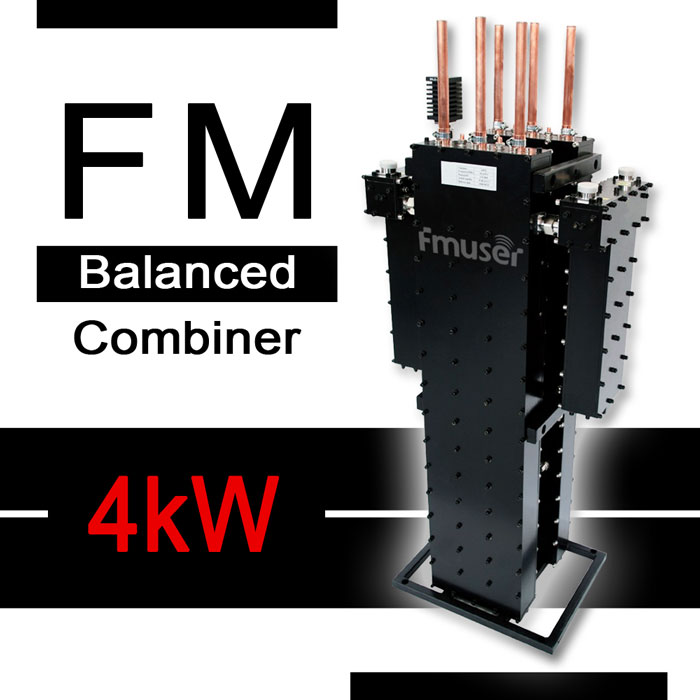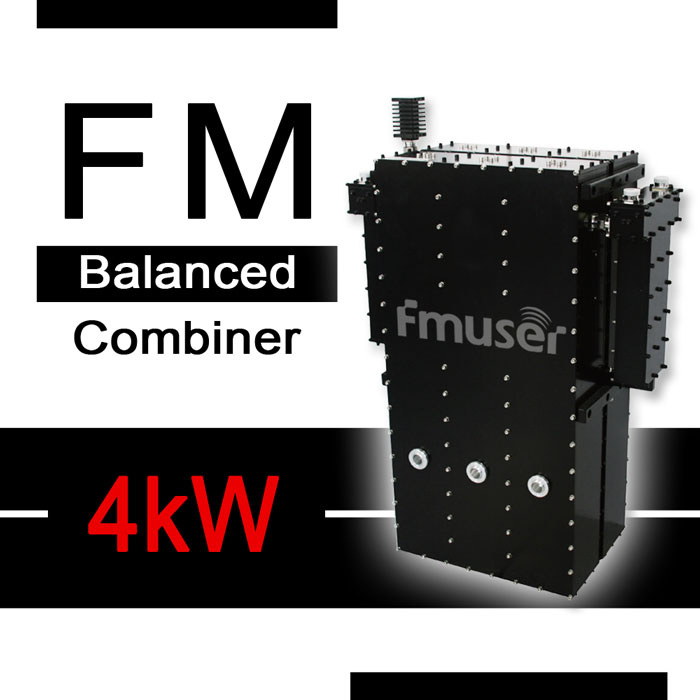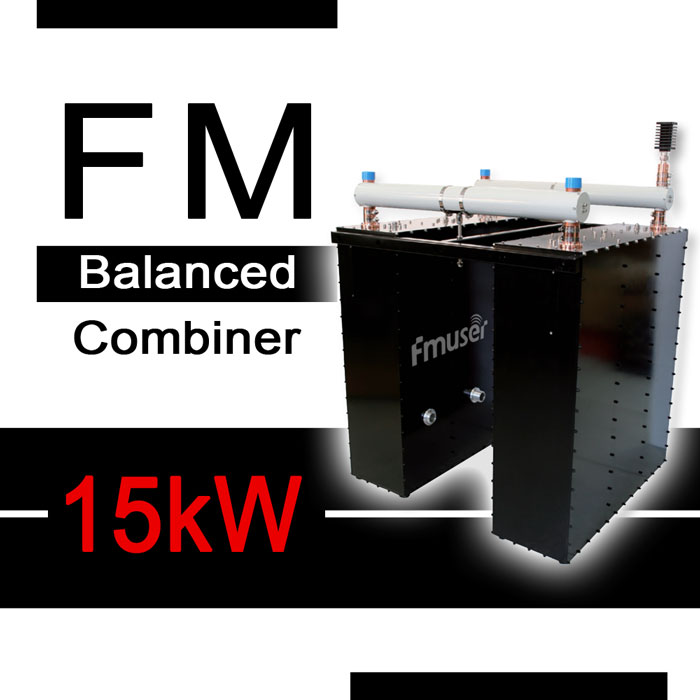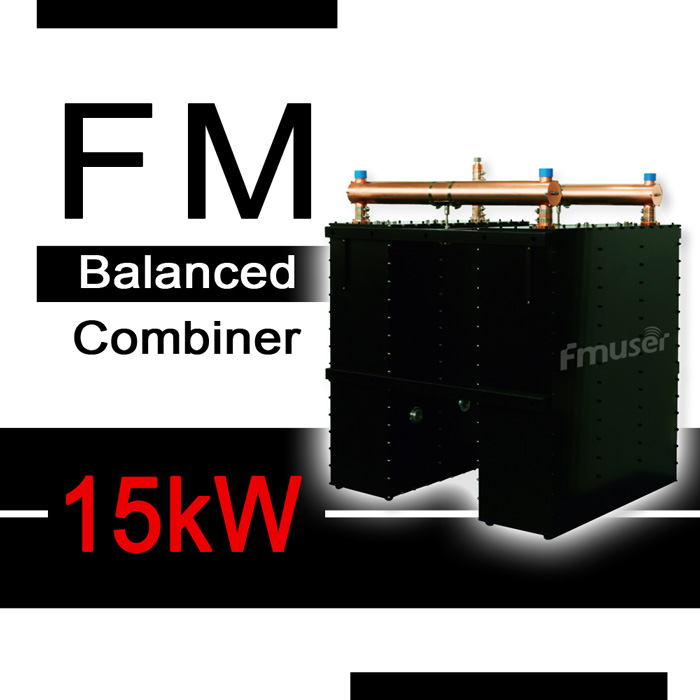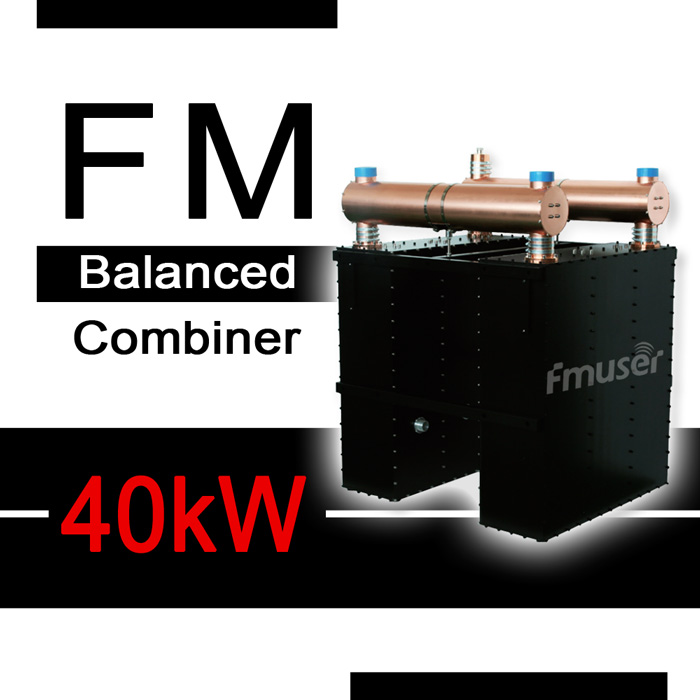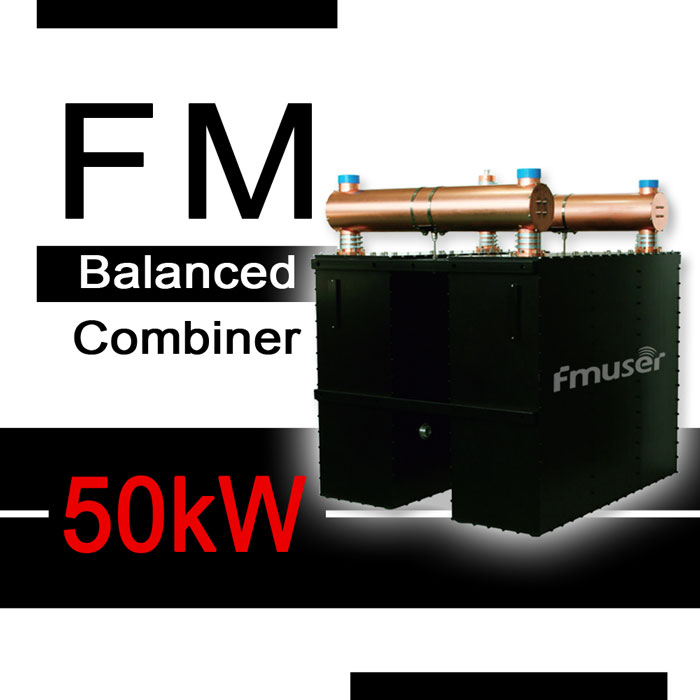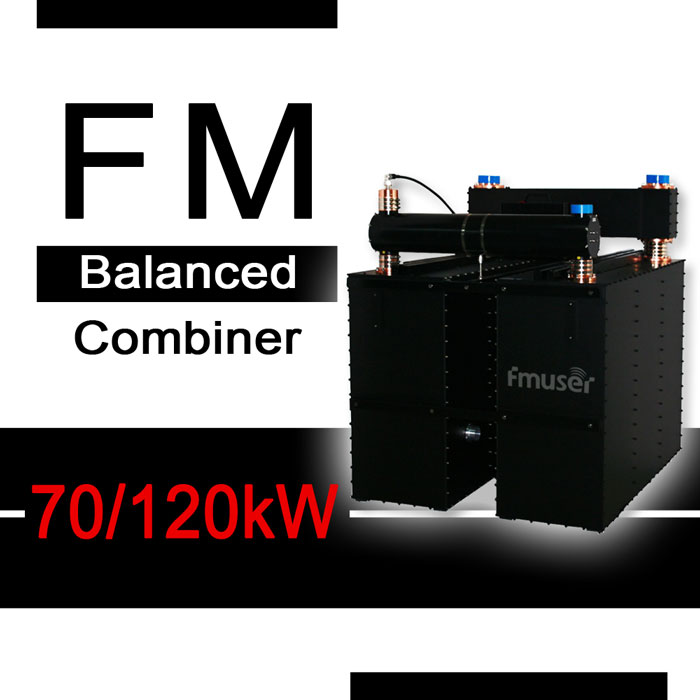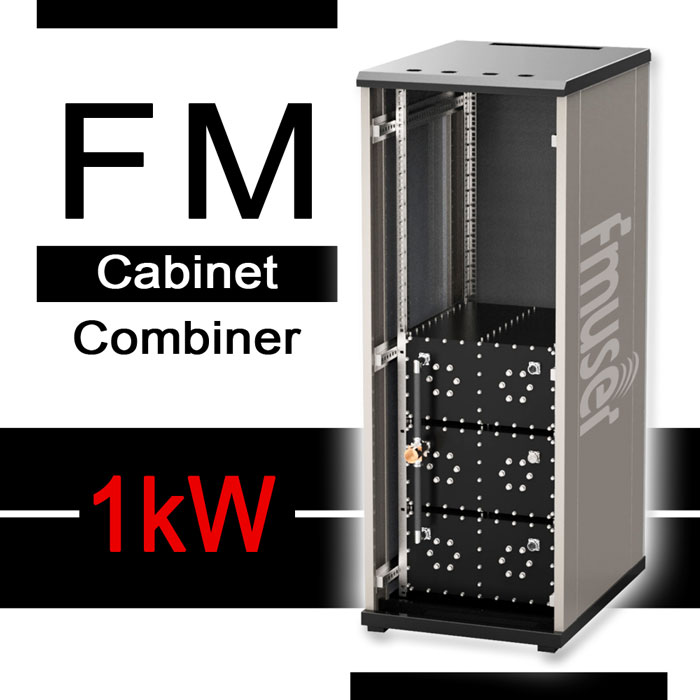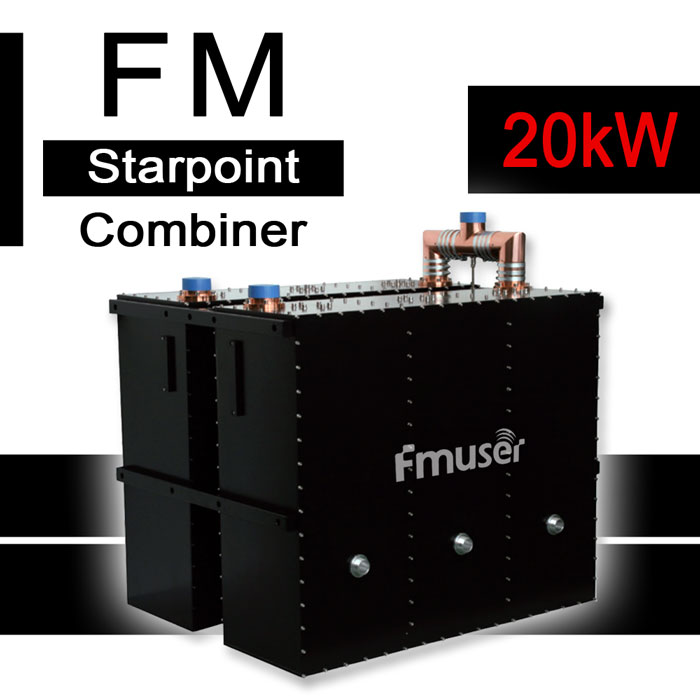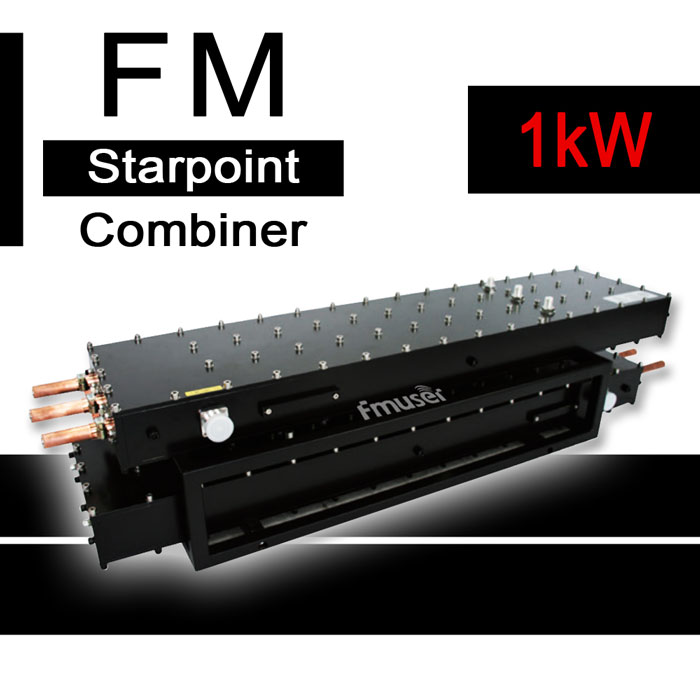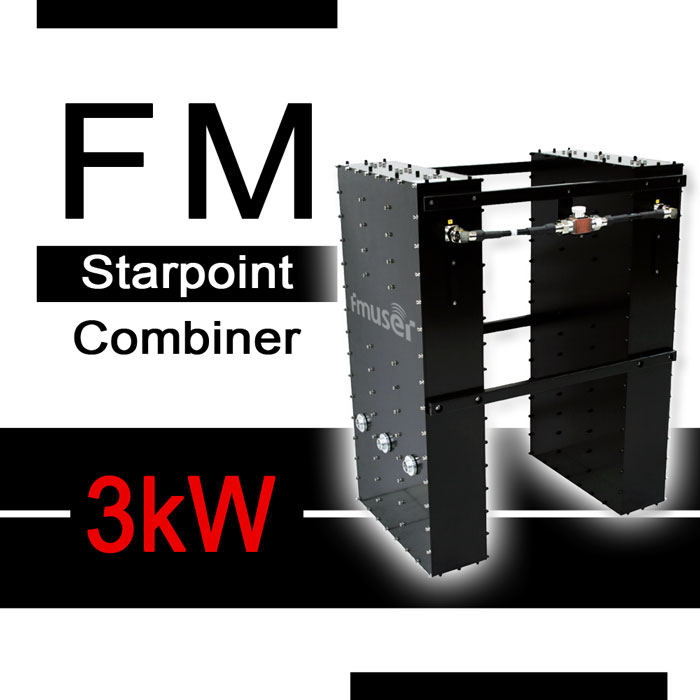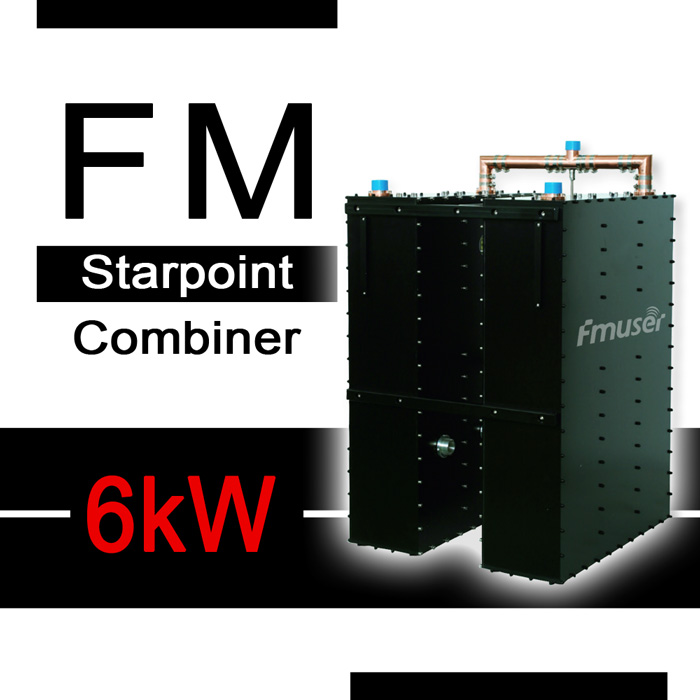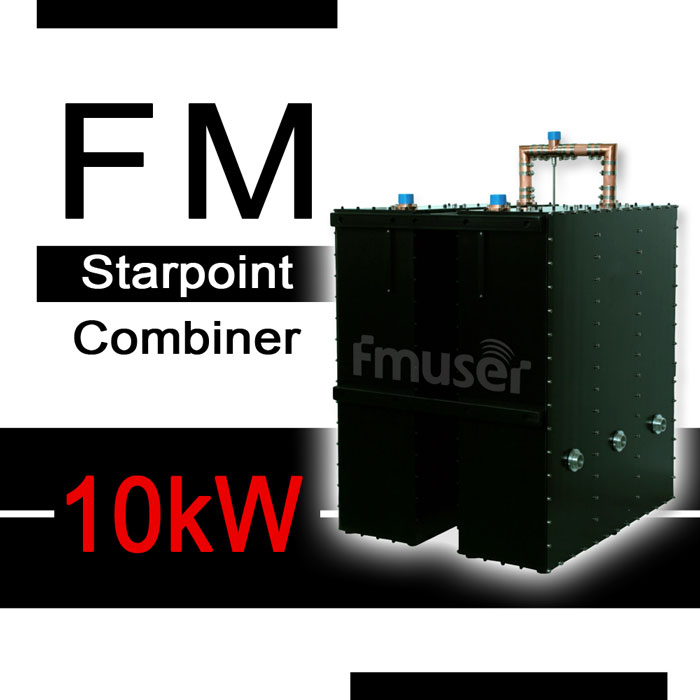
ترکیب کننده های FM
ترکیب کننده FM یک دستگاه الکترونیکی است که برای ترکیب دو یا چند فرستنده FM در یک سیستم آنتن واحد استفاده می شود. چندین فرستنده را قادر می سازد تا یک آنتن واحد را به اشتراک بگذارند که به نوبه خود امکان استفاده مجدد از فرکانس بیشتر و استفاده کارآمدتر از طیف رادیویی را فراهم می کند. ترکیب کننده های FM معمولاً به عنوان سیستم های ترکیب کننده FM، سیستم های ترکیبی یا شبکه های ترکیبی نیز شناخته می شوند.
-
![87-108 MHz 4kW Compact TX RX Systems Duplexer RF Channel Combiner with 3 or 4 Cavities and 7-16 DIN Input for FM Broadcasting]()
قیمت (دلار): قیمت را بخواهید
فروخته شده: 4
-
![87-108 MHz 4kW FM Combiner Solid State Duplexer Balanced CIB FM Transmitter Combiner with 3/4 Cavities for FM Radio Station]()
قیمت (دلار): قیمت را بخواهید
فروخته شده: 4
-
![87-108 MHz 15kW FM Combiner 3 or 4 Cavity Vari Notch Duplexer Solid State FM Transmitter Combiner with 1 5/8" Input for FM Radio]()
قیمت (دلار): قیمت را بخواهید
فروخته شده: 3
-
![87-108 MHz 15kW Compact TX RX Combiner 4 Cavity Duplexer Solid-state FM Transmitter Combiner with 1 5/8" Input for FM Broadcast]()
قیمت (دلار): قیمت را بخواهید
فروخته شده: 7
-
![87-108MHz 40kW Compact RF Power Combiner with 3 1/8" Input Solid-state FM CIB Balanced Duplexer for Signal Combiner Two Antennas]()
قیمت (دلار): قیمت را بخواهید
فروخته شده: 10
-
![87-108 MHz 50kW 3/4 Cavities FM Transmitter Combiner Solid State Duplexer with 3 1/8" Input High Power TX Combiner for FM Radio]()
قیمت (دلار): قیمت را بخواهید
فروخته شده: 10
-
![87-108 MHz 70kW/120 kW FM Combiner High Power Balanced CIB FM Transmitter Combiner 3 Cavity Duplexer for FM Radio Station]()
قیمت (دلار): قیمت را بخواهید
فروخته شده: 4
-
![87-108 MHz 1kW 1 5/8" 2 Cav. N-Channel FM Starpoint Combiner Radio Repeater Duplexer High Power Radio Combiner for FM Station]()
قیمت (دلار): قیمت را بخواهید
فروخته شده: 11
-
![87-108 MHz 2-Way 3 1/8" 20kW Starpoint FM Transmitter Combiner with 3 or 4 Cavities Compact tx rx duplexer for FM Radio Station]()
قیمت (دلار): قیمت را بخواهید
فروخته شده: 3
-
![87-108MHz 7-16 DIN 1kW Starpoint FM Transmitter Combiner Compact 4 Cavity Duplexer with Inner Duplexer Filter for FM Broadcast]()
قیمت (دلار): قیمت را بخواهید
فروخته شده: 13
-
![87-108MHz 7-16 DIN 3kW Branched Type FM Combiner Solid-state 2 Way Starpoint Cavity Duplexer with 3 or 4 Cavity for FM Station]()
قیمت (دلار): قیمت را بخواهید
فروخته شده: 13
-
![87-108MHz 6kW Starpoint FM Combiner 2 way RF Combiner Star Type Radio Duplexer with 1 5/8" Input and 3/4 Cavities for FM Station]()
قیمت (دلار): قیمت را بخواهید
فروخته شده: 4
-
![87-108MHz 10kW 3 or 4-Cavity Starpoint FM Transmitter Combiner Compact 2 Way Cavity Duplexer with 1 5/8" Input for FM Station]()
قیمت (دلار): قیمت را بخواهید
فروخته شده: 7
- کاربردهای FM Combiner چیست و رایج ترین کاربرد آن چیست؟
- ترکیب کننده های FM در سیستم های پخش رادیویی برای ترکیب چندین سیگنال رادیویی با فرکانس یکسان در یک خط انتقال برای پخش همزمان استفاده می شود. یکی از رایج ترین کاربردهای ترکیب کننده های FM، ترکیب چندین سیگنال ایستگاه رادیویی FM است تا بتوان آنها را روی یک آنتن پخش کرد. علاوه بر این، ترکیبکنندههای FM برای ترکیب سیگنالهای چندین فرستنده ایستگاه رادیویی FM واقع در مکانهای جغرافیایی مختلف برای ایجاد یک سیگنال واحد و ترکیبی استفاده میشوند که میتواند در یک منطقه وسیعتر پخش شود.
- چگونه بهترین ترکیب کننده های فرستنده FM را انتخاب کنیم؟ چند پیشنهاد...
- بسیاری از مشتریان به ما مراجعه میکنند و میپرسند، "هی، کدام نوع از ترکیبکنندههای FM برای فروش محبوبترین آنها هستند؟ قیمت ترکیبکننده FMUSER UHF/VHF چقدر است؟"، مطالب زیر درباره نحوه انتخاب بهترین سیستم ترکیبکننده برای ایستگاه پخش خود است.
برای انتخاب بهترین ترکیب کننده FM برای ایستگاه پخش، باید عواملی مانند تعداد فرستنده ها، توان موجود، اندازه آنتن و نوع آنتن های مورد استفاده را در نظر بگیرید. علاوه بر این، باید مشخصات ترکیب کننده مانند حداکثر فرکانس، جداسازی، از دست دادن درج و سایر ویژگی ها را نیز بررسی کنید. تحقیق در مورد بررسی های ترکیب کننده و همچنین تاریخچه سازنده و خدمات مشتری بسیار مهم است. در نهایت، شما باید قیمت ها را بین تامین کنندگان مختلف مقایسه کنید و محصولی را انتخاب کنید که به بهترین وجه با نیاز و بودجه شما مطابقت دارد.
همچنین باید به عوامل زیر توجه کنید:
شماره 1 مس، برنج با روکش نقره و آلیاژ آلومینیوم با کیفیت بالا بهتر است: رفیق، اگر در مورد کسب و کار بلندمدت ایستگاه رادیویی شماست، خواه یک ایستگاه رادیویی FM باشد یا یک ایستگاه تلویزیونی ملی، شما نمی خواهید به دلایل عجیب و غریب در روز شروع به کار آن رادیو متوقف شود. در مورد آن فکر کنید، منظورم این است که هیچ کس یک ماشین سنگین که هزاران دلار هزینه داشته باشد و زمان و تلاش زیادی داشته باشد، اما نتواند به طور مداوم کار کند، نمی خواهد؟ بنابراین، وقتی میتوانید ترکیبکنندهای با کارایی بالا از مواد بهتری مانند مس، برنج با روکش نقره و آلیاژ آلومینیوم با کیفیت بالا داشته باشید، باید به موقع تصمیم خود را بگیرید و FMUSER میتواند این نوع تجهیزات پخش حرفهای با کارایی بالا را در اختیار شما قرار دهد. ما تمام آنچه شما می خواهید را داریم.
شماره 2 شما به یک ترکیب کننده حرفه ای تر نیاز دارید: تیم فنی ما بازخوردهای زیادی از این قبیل دریافت کرد: "خدایا، از زمانی که رئیس ما یک کمباین دو طرفه را به هزاران دلار از برخی سازندگان ناشناس تجهیزات رادیویی خرید، تعداد طرفداران برنامه رادیویی ما به شدت کاهش یافته است." یا "دیگر نمی توانم آن ترکیب بیچاره را تحمل کنم!" سپس صمیمانه به آنها پیشنهاد می کنیم: "چرا یک ترکیب کننده RF چند کاناله حرفه ای انتخاب نکنید؟" در اکثر ایستگاه های رادیویی مشتریان ما، چندین فرستنده FM یا فرستنده تلویزیون حالت جامد وجود دارد. در حال حاضر، آن ترکیب کننده های ضعیف نمی توانند نیازهای مدرن انتقال حرفه ای چند کاناله را برآورده کنند. به تجهیزات بهتری نیاز دارید. FMUSER تقریباً تمام ترکیبکنندههای حرفهای چند کاناله را که میتوانید در بازار پیدا کنید، پوشش میدهد. بیایید چت کنیم، مطمئناً بهترین را پیدا خواهید کرد
شماره 3 از آنچه مخاطبان شما لذت می برند لذت ببرید: چرا تا زمانی که می توانید اجازه ندهید مخاطبان از برنامه رادیویی بهتر لذت ببرند. آیا مخاطب شما واقعاً مایل است به آن برنامه های رادیویی پر از سر و صدای خشن گوش دهد؟ چگونگی داشتن کیفیت نهایی برنامه های رادیویی به یکی از اهداف بسیاری از مشتریان تکراری برند ما تبدیل شده است. البته مهم نیست که یک رادیو شهر کوچک باشید یا یک ایستگاه رادیویی ملی، نمی خواهید مخاطبان ارزشمند خود را از دست بدهید. خوشبختانه میتوانید با بهروزرسانی تجهیزات پخش حرفهای خود شروع کنید، زمانی که میتوانید تجهیزات ایستگاه رادیویی چند منظوره با اعوجاج بسیار کم، افت ورودی و ترکیبکننده RF کم از FMUSER را داشته باشید، برای مثال، لطفاً درنگ نکنید. بسیار مفتخریم که در خدمت شما و مخاطبانتان هستیم
شماره 4 اندازه به همان اندازه مهم است: به طور کلی، مساحت کل اتاق ایستگاه رادیویی به اندازه استودیوی پخش نخواهد بود و تجهیزات پخش لازم زیادی مانند فرستندههای پخش کابینت، فیدرها، بادکنندههای موجبر و غیره وجود دارد که به این معنی است. اینکه تیم فنی شما باید به طور منطقی مکانی را برای کمباین ترتیب دهد بدون اینکه روی کار آن تجهیزات گران قیمت تأثیر بگذارد، ممکن است کمباین معمولی برای ورود به اتاق رک خیلی بزرگ باشد، که ثابت می کند طراحی جمع و جور یکی از دلایل مهم این است که کمباین RF ما هنوز در ایستگاه های پخش بزرگ و متوسط محبوب است
#5 ساختار داخلی هنوز باید در نظر گرفته شود: چه نوع تجهیزات پخش را می توان تجهیزات پخش عالی نامید؟ این سوالی است که قابل تامل است. ترکیب کننده را به عنوان مثال در نظر بگیرید. در صدها بازخورد پس از فروش ترکیبکنندههای RF ما که در سرتاسر جهان فروخته شد، محتوای جالبی یافتیم: بیش از نیمی از مشتریان ما گزارش دادند که اولین بار هنگام استعلام قیمت و ظاهر را در نظر نگرفتند. برعکس، آنها توسط برخی از جزئیات که مردم عادی نمی توانستند به آنها توجه کنند جذب شدند، به عنوان مثال، زمانی که جک از لندن علاقه زیادی به یکی از راه حل های پخش کلید در دست ما برای ایستگاه رادیویی شهرداری خود نشان داد، ما به او یک دستگاه چند منظوره سفارشی ارائه کردیم. ترکیب کننده فرستنده 40 کیلوواتی با سه حفره. بزرگترین ویژگی این مدل ساختار ساده و ادغام چند فرکانس مناسب آن است. در واقع، ایستگاه رادیویی جک یکی از مشهورترین ایستگاههای رادیویی در منطقه است و آن کمباینر 40 کیلوواتی هنوز از سال 2014 به جک و مخاطبانش خدمات میدهد. البته این تنها یکی از بازخوردهای عالی پس از فروش کمباینهای RF ما است. بسیاری از مشتریان دیگر ارزیابی کردند که کمباین ما دارای افزایش دما اندک، طراحی ظرفیت توان اضافی حرفه ای، ترکیب قدرت و غیره است. ما این توانایی و اطمینان را داریم که خدمات پخش بهتری به شما ارائه دهیم.
- چگونه از ترکیب کننده FM در ایستگاه پخش به درستی استفاده کنیم؟
- مراحل استفاده صحیح از یک ترکیب کننده FM در ایستگاه پخش عبارتند از:
1. سیستم آنتن را از نظر هرگونه منابع تداخل احتمالی بررسی کنید.
2. ترکیب کننده FM را به سیستم آنتن وصل کنید.
3. اطمینان حاصل کنید که همه فرستنده ها به درستی کالیبره شده اند و فرکانس کاری صحیح دارند.
4. هر فرستنده را به ترکیب کننده FM وصل کنید.
5. آفست فرکانس هر فرستنده را بررسی کنید تا مطمئن شوید که مطابق با الزامات تحمل فرکانس FCC است.
6. از ترکیب کننده برای ترکیب سیگنال های فرستنده های مختلف استفاده کنید.
7. قدرت سیگنال سیگنال ترکیبی را کنترل کنید و در صورت لزوم تنظیمات را انجام دهید.
مشکلاتی که باید هنگام استفاده از یک ترکیب کننده FM اجتناب کنید عبارتند از:
1. کیفیت ضعیف سیگنال به دلیل تداخل یا تغییر فرکانس.
2. بارگذاری بیش از حد ترکیب کننده با اتصال فرستنده های زیاد.
3. قدرت سیگنال ناکافی به دلیل پیکربندی نامناسب سیستم آنتن.
4. دریافت ضعیف به دلیل آنتن دهی نادرست.
5. فرستنده های کالیبره نادرست.
- ترکیب کننده FM چگونه در ایستگاه پخش کار می کند؟
- ترکیب کننده های FM در یک ایستگاه پخش برای ترکیب چندین سیگنال FM در یک سیگنال برای پخش استفاده می شود. این کار با ترکیب چندین سیگنال FM در یک پورت خروجی انجام می شود. ترکیب کننده FM به عنوان یک فیلتر عمل می کند تا اطمینان حاصل کند که فقط سیگنال های مورد نظر به گیرنده می رسد. همچنین به ایستگاه اجازه می دهد تا چندین سیگنال را در یک سیگنال ترکیب کند که باعث افزایش دسترسی ایستگاه می شود و به آنها اجازه می دهد تا به چندین مکان پخش شوند.
- چرا ترکیب کننده FM مهم است و آیا برای یک ایستگاه پخش ضروری است؟
- ترکیبکنندههای FM مهم هستند زیرا به چندین ایستگاه پخش FM اجازه میدهند در یک محدوده فرکانسی بدون تداخل با یکدیگر کار کنند. داشتن یک ترکیب کننده همچنین به یک ایستگاه پخش اجازه می دهد تا به مخاطبان بیشتری دسترسی پیدا کند، زیرا تمام ایستگاه های موجود در ترکیب کننده توسط شنوندگان قابل شنیدن هستند. اگر یک ایستگاه پخش میخواهد در همان محدوده فرکانسی با ایستگاههای دیگر کار کند، لازم است که یک ترکیبکننده داشته باشد.
- چند نوع ترکیب کننده FM وجود دارد؟
- سه نوع اصلی از ترکیب کننده های FM وجود دارد: غیرفعال، فعال و ترکیبی. ترکیب کننده های غیرفعال به سادگی سیگنال های چند فرستنده را ترکیب کرده و آنها را روی یک آنتن ارسال می کنند. ترکیبکنندههای فعال پیچیدهتر هستند و از اجزای فعال مانند تقویتکنندهها و فیلترها برای اطمینان از کیفیت بالاتر سیگنال استفاده میکنند. ترکیبکنندههای هیبریدی ویژگیهای ترکیبکننده غیرفعال و فعال را ترکیب میکنند تا تعادلی بین کیفیت و هزینه سیگنال ایجاد کنند.
- چگونه یک ترکیب کننده FM را در ایستگاه پخش به درستی وصل کنیم؟
- برای اتصال صحیح یک ترکیب کننده FM در یک ایستگاه پخش، مراحل زیر باید انجام شود:
1. هادی مرکزی هر خط ورودی را به هادی مرکزی یکی از خطوط خروجی ترکیب کننده وصل کنید.
2. شیلد هر خط ورودی را به شیلد همان خط خروجی وصل کنید.
3. هادی های مرکزی باقی مانده از خطوط خروجی را به هم وصل کنید.
4. سپرهای باقی مانده از خطوط خروجی را به هم وصل کنید.
5. خطوط خروجی را به فرستنده FM وصل کنید.
6. خطوط ورودی را به محرک های FM وصل کنید.
- تجهیزات مربوط به ترکیب کننده FM در ایستگاه پخش چیست؟
- تجهیزات مربوط به یک ترکیب کننده FM در یک ایستگاه پخش معمولاً شامل: فرستنده، تقویت کننده قدرت، سیستم آنتن، ترکیب کننده پخش، دوبلکسر، فیلتر باند گذر، آرایه آنتن، سیستم کنترل و برج می باشد.
- مهمترین مشخصات فیزیکی و RF کامباینر FM چیست؟
- مهمترین مشخصات فیزیکی و RF یک ترکیب کننده FM شامل محدوده فرکانس، افت درج، افت برگشت، ایزوله، رد هارمونیک و کنترل توان است. علاوه بر این، ترکیب کننده باید دارای نویز کم، خطی بودن خوب و سطح بالایی از قابلیت اطمینان باشد.
- چگونه می توان یک ترکیب کننده FM را در ایستگاه پخش به عنوان مهندس به درستی نگهداری کرد؟
- برای انجام صحیح تعمیر و نگهداری روزانه یک ترکیب کننده FM در ایستگاه پخش، مهندس باید:
1. نمای بیرونی کمباین را از نظر علائم آسیب یا ساییدگی بررسی کنید.
2. بررسی کنید که همه اتصالات ایمن و سالم باشند.
3. سطوح قدرت را بررسی کنید و تنظیمات لازم را انجام دهید.
4. آنتن را از نظر هرگونه نشانه ای از آسیب یا خوردگی بررسی کنید.
5. فیلترها را بررسی کنید و مطمئن شوید که به درستی تراز و کار می کنند.
6. ترکیب کننده را از نظر هرگونه نشانه ای از تداخل یا اعوجاج بررسی کنید.
7. برای اطمینان از عملکرد صحیح، تعادل RF را انجام دهید.
8. سطوح توان خروجی را بررسی کرده و در صورت نیاز تنظیم کنید.
9. سیستم را برای هر گونه بی نظمی یا مشکل زیر نظر بگیرید.
10. هر قسمت را در صورت نیاز تمیز یا تعویض کنید.
- اگر یک ترکیب کننده FM کار نمی کند چگونه به درستی تعمیر کنیم؟
- برای تعمیر یک ترکیب کننده FM، ابتدا باید علت خرابی آن را شناسایی کنید. اگر کمباین دارای فیوزهای سوخته است، می توانید آنها را با فیوزهای جدید تعویض کنید. اگر کمباین از تداخل الکتریکی رنج می برد، می توانید خازن ها را تعویض کنید یا از مواد محافظ برای کاهش تداخل استفاده کنید. اگر ترکیب کننده مشکل اتصال دارد، می توانید اتصالات را بررسی کرده و قطعات شکسته را تعویض کنید. اگر کمباین مشکل مکانیکی دارد می توانید قطعات شکسته را تعویض کنید. حتما قطعاتی را تهیه کنید که با ترکیب کننده سازگار باشد. همچنین ممکن است لازم باشد تنظیمات ترکیب کننده را تنظیم کنید تا مطمئن شوید که به درستی کار می کند.
- بدنه کمباین FM عموما از چه نوع ماده ای ساخته شده است؟
- بدنه کمباین FM عموماً از فلز مانند آلومینیوم یا فولاد ساخته شده است و این مواد می توانند بر عملکرد آن تأثیر بگذارند. مواد فلزی می توانند تداخل منابع خارجی را کاهش دهند و به محافظت از اجزای داخلی در برابر آسیب کمک کنند. با این حال، اگر پوشش فلزی بیش از حد ضخیم باشد، می تواند تلفات اضافی ایجاد کند و کارایی کلی ترکیب کننده را کاهش دهد.
- ساختار اصلی ترکیب کننده FM چیست؟
- ساختار اصلی یک ترکیب کننده FM شامل یک سر ترکیب کننده (همچنین به عنوان کابینت کامباینر نیز شناخته می شود)، یک دوبلکسر، یک فیلتر باند گذر و یک تقویت کننده قدرت است. سر ترکیب کننده شامل اجزای کنترل کننده مانند یک پردازنده کنترلی، مبدل های دیجیتال به آنالوگ و سایر عناصر کنترلی است. دوبلکسر وظیفه جداسازی سیگنال های ارسال و دریافت را بر عهده دارد. فیلتر باند پاس وظیفه رد فرکانس های ناخواسته و انتخاب محدوده فرکانس مورد نظر را بر عهده دارد. تقویت کننده قدرت وظیفه افزایش قدرت سیگنال را بر عهده دارد.
- سر ترکیب کننده ویژگی ها و عملکرد ترکیب کننده FM را تعیین می کند. اگر هد کمباین وجود نداشته باشد، ترکیب کننده FM نمی تواند به طور عادی کار کند. اجزای دیگر مانند دوبلکسر، فیلتر باند گذر و تقویت کننده برق، همگی باید به هد ترکیب کننده متصل شوند تا بتوانند به درستی کار کنند.
- در یک ایستگاه پخش، چه کسی باید به مدیریت ترکیب کننده FM اختصاص یابد؟
- شخصی که باید برای مدیریت یک ترکیب کننده FM منصوب شود باید درک خوبی از قدرت سیگنال داشته باشد و باید مهارت ها و دانش فنی برای نصب، نگهداری و عیب یابی تجهیزات را داشته باشد. آنها باید بتوانند به طور مستقل کار کنند و مهارت های سازمانی و ارتباطی قوی داشته باشند.
- چگونه بسته بندی مناسب را برای یک ترکیب کننده FM انتخاب کنیم؟
- هنگام انتخاب بسته بندی مناسب برای ترکیب کننده FM، مهم است که اندازه، وزن و شکنندگی مورد را در نظر بگیرید. باید به گونه ای بسته بندی شود که از ضربه، تغییرات دما و رطوبت محافظت کند. علاوه بر این، باید به گونه ای در بسته بندی محکم شود که از جابجایی یا سر خوردن آن جلوگیری شود. هنگام حمل و نقل کمباین FM، مهم است که اطمینان حاصل کنید که بسته با اطلاعات حمل و نقل صحیح برچسب خورده است و به درستی مهر و موم شده است تا آسیب احتمالی به حداقل برسد.
- حال شما چطور است؟
- من خوبم
تماس با ما


FMUSER INTERNATIONAL GROUP LIMITED.
ما همیشه محصولات قابل اعتماد و خدمات قابل توجهی به مشتریان خود ارائه می دهیم.
اگر می خواهید مستقیماً با ما تماس بگیرید ، لطفاً به اینجا بروید تماس با ما
